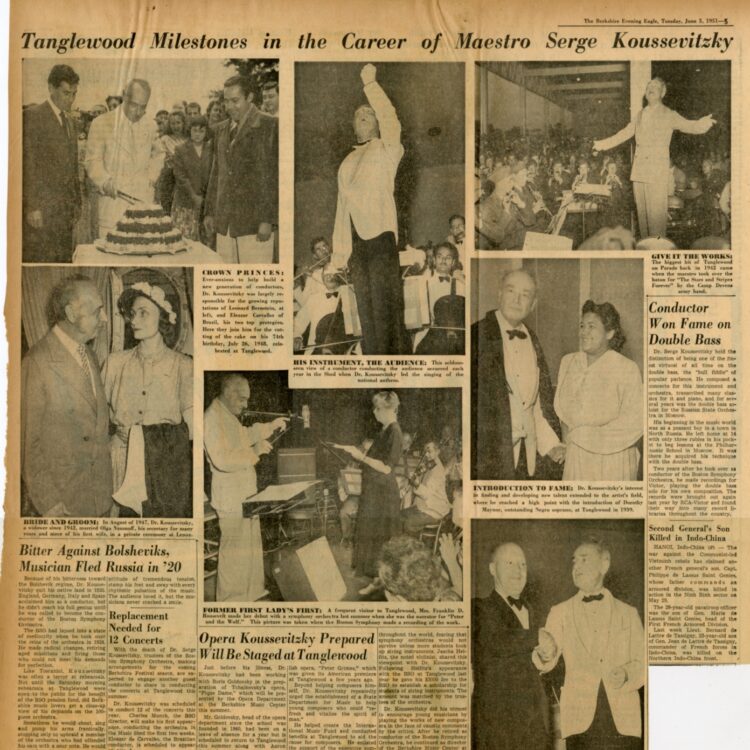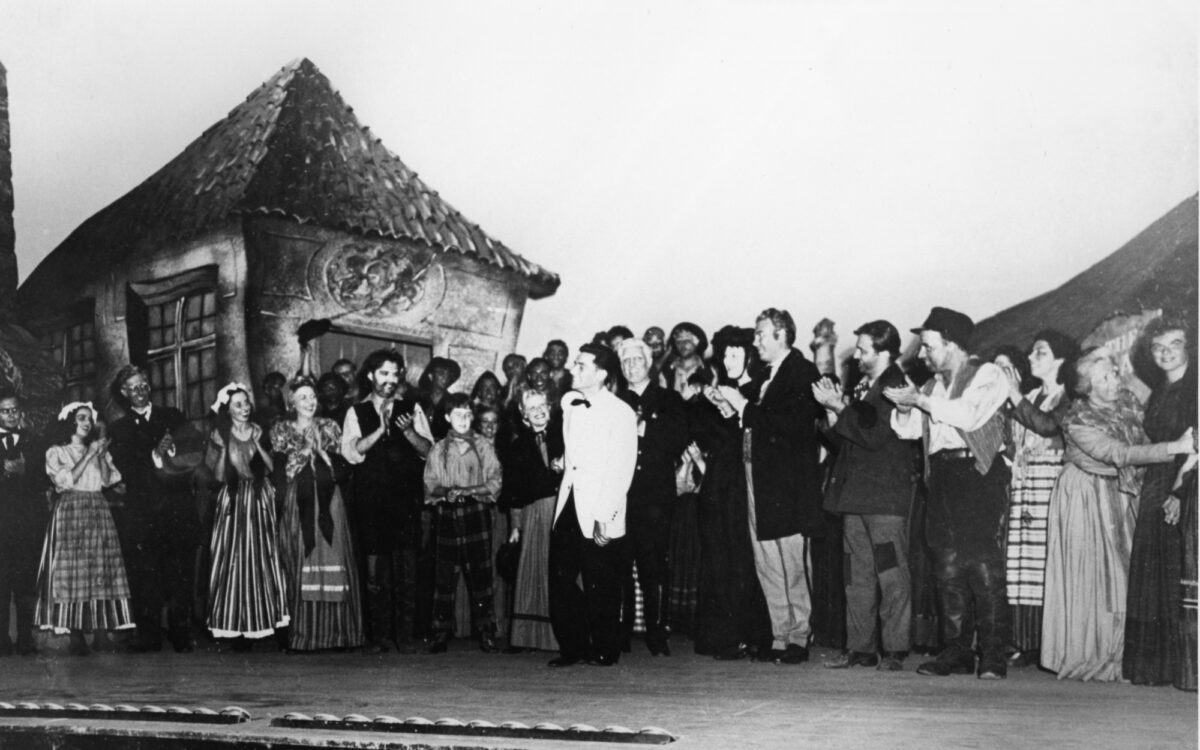Koussevitzky at Tanglewood
From the BSO's involvement in the Berkshire Festival, the receipt of a gift of land, the foundation of a summer school for music mentorship, maintaining music during a War, and expanding the festival in the post-War years, Serge Koussevitzky's impact on Tanglewood is still felt today.
This exhibit was created as part of the Koussevitzky 150 celebrations at Tanglewood.

Newspaper article published the day after Koussevitzky's death highlighting his accomplishments in the Berkshires
The Berkshire Evening Eagle, June 5, 1951
-
August 1936
![People walk across a lawn in front of a big white tent]()
Holmwood grounds with tent. Photographer unknown.
First performance with the Berkshire Festival
After their relationship with Henry Hadley and the New York Philharmonic dissolves, the Berkshire Festival organizers invite Serge Koussevitzky to conduct the BSO. Koussevitzky leads the orchestra in three concerts on August 13, 15, and 16, 1936, with crowds that overflow the capacity of the 3,600-seat tent on the Holmwood estate.
-
Winter of 1936-1937 Season
![Front view of large house with lawn in front and trees on the side]()
A hand-colored postcard of the Tanglewood manor house, ca. 1905, when it was still owned by members of the Tappan family.
Gift of the Tanglewood Estate
During a Symphony Hall concert conducted by Koussevitzky, Mrs. Gorham Brooks decides to give the BSO the Tanglewood estate so that there will be a permanent home for the Berkshire Festival concerts.
-
August 1937
![Newspaper clipping depicting audience members holding umbrellas inside the concert tent]()
Rained Out
The Festival expands to two weekends of concerts. Koussevitzky conducts the first weekend of concerts without a hitch, drawing over 8,000 attendees. However, the all-Wagner program during the second weekend is drenched in a torrential downpour. Festival organizer Gertrude Robinson Smith makes an impromptu speech and immediately raises $30,000 to build a shed.
-
Winter of 1937-1938 Season
![Construction crews work around half built frames]()
Shed construction. Photograph from Music Under the Moon by John G.W. Mahanna.
The Shed is Built
Koussevitzky selects Finnish-born architect Eliel Saarinen to design the plans for the Shed. Saarinen proposes an elaborate design for a music pavilion, which exceeds the $100,000 budget. Saarinen modifies his plans twice and then gives up on the project, writing that if the trustees insist on remaining within their budget, they will have “just a shed.” Stockbridge engineer and festival trustee Joseph Franz is called on to simplify the plans and oversees the “Shed” to completion.
-
August 1938
![Program cover and program page for first concert in the Music Shed]()
Concert program of first BSO concert in the Shed. Courtesy of the BSO Archives.
Shed Dedication
Koussevitzky conducts the inaugural concert in the Shed on August 4, 1938. Gertrude Robinson Smith gives a dedicatory speech. Since that time, more than 2,900 concerts and open rehearsals have taken place in the Shed. It was rededicated as the Koussevitzky Music Shed in honor of Koussevitzky on the occasion of the Shed’s 50th anniversary in 1988.
-
1939
![Koussevitzky and his wife Natalie stand on the balcony of Seranak, their summer home near Tanglewood]()
Natalie and Serge Koussevitzky stand on the balcony of Seranak, their summer home near Tanglewood
Photographer unknown
Purchase of Seranak
Koussevitzky and his wife Natalie purchase the Bald Hill Farm estate near Tanglewood, and rename it Seranak, an acronym for Serge and Natalie Koussevitzky. The home will grow to play a vital role in supporting the activities of the Music Center, through hosting fundraisers, housing visiting guest artists, and providing space for masterclasses.
-
Summer 1940
![An elongated image depicts the entire class and faculty of the first Tanglewood Music Center]()
Tanglewood Music Center 1940 Class Photo
The 1940 class picture shows Tanglewood Music Center faculty, students, and staff assembled in front of the “Main House” that served for 54 years as the headquarters for TMC activities. The faculty chosen by Koussevitzky included Aaron Copland, Paul Hindemith, G. Wallace Woodworth, Olin Downes, Richard Burgin, as well as BSO members. Koussevitzky taught the most gifted conducting students, including Leonard Bernstein, Thor Johnson, Richard Bales, and Lukas Foss.
Photograph by E. J. Curtis.
The Tanglewood Music Center
The donation of the Tanglewood estate to the BSO paves the way for Koussevitzky to create an “Academy for living and working in Music.” The Tanglewood Music Center opens its doors in 1940 with classes in conducting, composition, chamber music, and choral activities.
-
Summer 1941
![Theatre-Concert Hall dedicatory concert program]()
Theatre-Concert Hall dedicatory concert program
Dedication of the Theatre-Concert Hall
Koussevitzky conducts the inaugural concert in the Theatre-Concert Hall on July 13, 1941. The hall was built to accommodate the opera activities of the music center.
-
Summer 1942
![Serge Koussevitzky stands in front of the Tanglewood Music Center Orchestra in the Music Shed during the summer of 1942]()
Serge Koussevitzky and the Berkshire Music Center Advanced Orchestra, 1942
Following weeks of classes and rehearsals, the student orchestra performed three series of weekend concerts in the Shed, beginning August 1, 1942.
Photograph by E.J. Curtis
A Student-Led Festival
When the BSO cancels its participation in the 1942 Berkshire Music Festival due to rationing of gasoline and other World War II restrictions, BSO Music Director Serge Koussevitzky underwrites the activities of the music center and builds the festival around the student orchestra. He conducts the U.S. concert premiere of Shostakovich's Symphony No. 7 on August 14.
-
Summer 1943
![Program for chamber concert at Lenox Library organized by Serge Koussevitzky and featuring Leonard Bernstein on piano, 1943]()
Program for lecture-recital at the Lenox Library on August 28, 1943, featuring a lecture by Serge Koussevitzky and music performed by Leonard Bernstein. Courtesy Lenox Library Association.
Lenox Library Concerts
To keep music going during the War, Koussevitzky organizes a small series of chamber music concerts that took place in the Lenox Library Association’s Sedgwick Hall in 1943.
-
1944-1945
![]()
Mozart Festival concert program cover, 1944
Bach-Mozart Festival Concerts
In 1944 and 1945, Koussevitzky hosts a series of Bach and Mozart festivals in the Theatre-Concert Hall on the Tanglewood grounds.
-
Summer 1946
![Conductor Leonard Bernstein (center, in white jacket) on the Theatre-Concert Hall stage for the curtain call of the U.S. Premiere of Britten's Peter Grimes, performed by students of the Tanglewood Music Center opera department at Tanglewood, August 1946]()
Conductor Leonard Bernstein (center, in white jacket) on the Theatre-Concert Hall stage for the curtain call of the U.S. Premiere of Britten's Peter Grimes, performed by students of the Tanglewood Music Center opera department at Tanglewood, August 1946.
Photograph by Phillip E. Wollock
Return to Full Festival
The Berkshire Festival surpasses pre-War levels of activity with 13 concerts over five weekends. Koussevitzky brings in notable soloists such as Carol Brice, Mischa Elman, Gregor Piatigorsky, and Claudio Arrau. He also conducts the U.S. premiere of Shostakovich's Symphony No. 9, and the Tanglewood Music Center performs the U.S. premiere of Britten's Peter Grimes (commissioned by the Koussevitzky Music Foundation and conducted by Leonard Bernstein).
-
Summer 1947-1948
![Frances Yeend, Eunice Alberts, David Lloyd, and James Pease stand onstage at the curtain call following the BSO's performance of Beethoven's Symphony No. 9, ca. August 5, 1947]()
Vocal soloists (from left) Frances Yeend, Eunice Alberts, David Lloyd, and James Pease at the curtain call following the BSO's performance of Beethoven's Symphony No. 9, August 5, 1947.
Photograph by Gene Mitchell.
The Festival Grows
Koussevitzky continues to bring in notable soloists including William Primrose, Ella Goldstein, Jacob Lateiner, Joseph Battista, Frances Yeend, Eunice Alberts, David Lloyd, and James Pease in 1947 and Lukas Foss, Isaac Stern, David Lloyd, James Pease, Wesley Addy, Carol Brice, and Seymour Lipkin in 1948.
-
Summer 1949
![Serge Koussevitzky and violin virtuoso Jascha Heifetz acknowledge applause following Heifetz’ performance of the Tchaikovsky Violin Concerto at Tanglewood, August 4, 1949]()
Serge Koussevitzky and violin virtuoso Jascha Heifetz acknowledge applause following Heifetz’ performance of the Tchaikovsky Violin Concerto at Tanglewood, August 4, 1949.
Photograph by Heinz Weissenstein, Whitestone Photo
Koussevitzky Retires
At the conclusion of the 1949 Tanglewood season, Serge Koussevitzky retires from his 25-year tenure as Music Director of the BSO. His final concert as Music Director of the BSO takes place on August 14, 1949. That summer he premieres Randall Thompson's Last Words of David, and conducts the U.S. premiere of Britten's Spring Symphony. Notable soloists include Claudio Arrau, Jascha Heifetz, Gregor Piatigorsky, and Leonard Bernstein (reprising his second symphony, which had premiered in Symphony Hall in April).
-
Summer 1950
![Soloist Eleanor Roosevelt clasps the hand of conductor Serge Koussevitzky after a performance of Peter and the Wolf at Tanglewood]()
Serge Koussevitzky and narrator Eleanor Roosevelt acknowledge the audience and BSO members after the performance of Tchaikovsky's Peter and the Wolf in the Koussevitzky Music Shed at Tanglewood, August 11, 1950.
Photograph by Heinz Weissenstein, Whitestone Photo
Koussevitzky Retains Titles at Tanglewood
His love for Tanglewood compels Koussevitzky to retain his role as director of both the festival and music center for the summer after his retirement. Former first lady Eleanor Roosevelt performs as narrator for Peter and the Wolf, both for live performance and a special recording session in August 1950. He conducts his final concert at Tanglewood on August 13, 1950.
-
June 4, 1951
![]()
Funeral procession for Serge Koussevitzky leaving the Church on the Hill in Lenox, MA in June 1951.
Photographer unknown
Koussevitzky Dies
Mere weeks before the start of the 1951 Tanglewood season, Serge Koussevitzky dies and is buried in Lenox.
-
August 9, 1951
![Leonard Bernstein at piano, rehearses with singers Adele Addison, Eunice Alberts, James Pease, and David Lloyd]()
Leonard Bernstein at piano, rehearses with singers Adele Addison, Eunice Alberts, James Pease, and David Lloyd for the August 9, 1951 performance of Beethoven's Missa Solemnis in memory of Serge Koussevitzky.
Photograph by Will Plouffe
Koussevitzky is remembered at the 1951 Festival through a performance of Beethoven's Missa Solemnis, conducted by his protégé Leonard Bernstein.

















